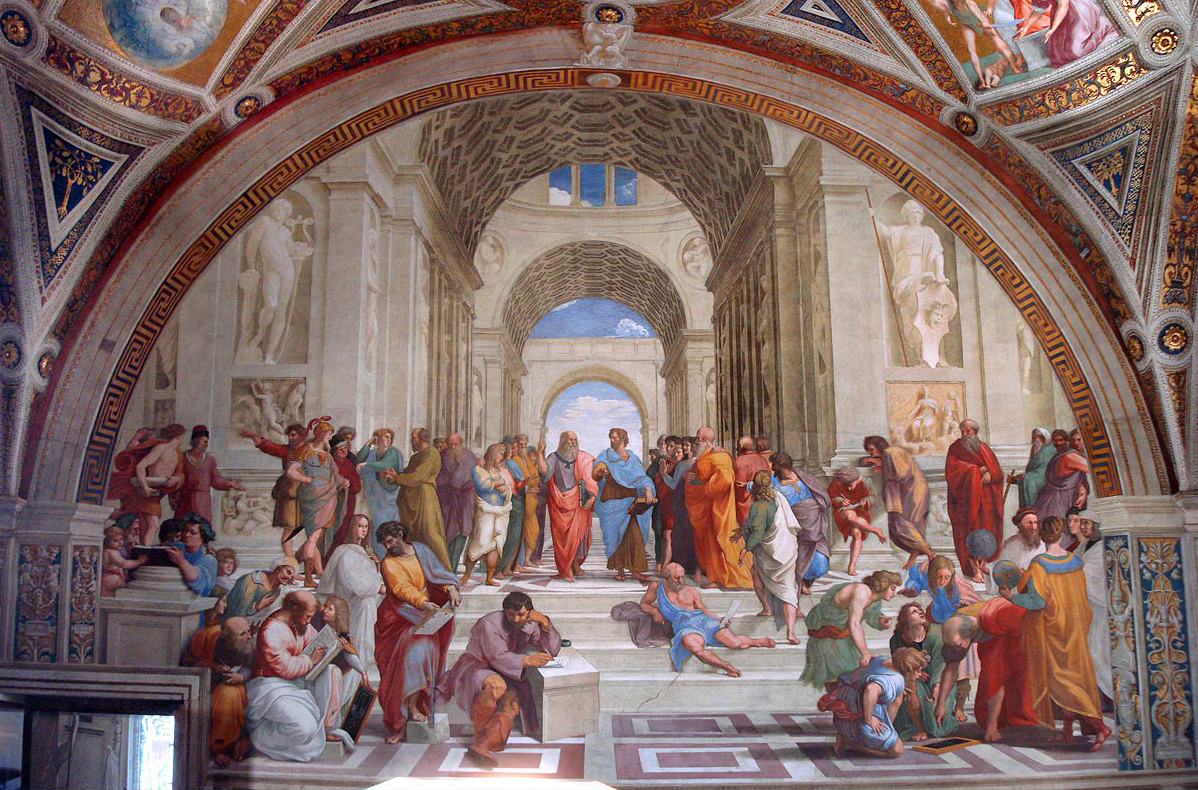Raphael
Raffaello Sanzio da Urbino
(1483-1520, Italian)
Together with Leonardo da Vinci and Michelangelo, he forms the traditional trinity of great masters of High Renaissance.
 |
| Self-portrait (aged ~23) - Raphael - tempera on panel (47.5 x 33 cm) 1504-06 - Pitti Palace, Gallerie degli Uffizi (Florence) |
In the Apostolic Palace of Vatican, the public Stanze suite is the 4 Raphael Rooms that are famous for their frescoes, painted by Raphael and his workshop, under the order of Pope Julius II (1443-1503-1513).
 |
| Portrait of Pope Julius II - Raphael - oil on poplar wood (109 x 81 cm) 1511 - National Gallery (London) |
Stanza della Segnatura
The Stanza della Segnatura room includes these frescoes:
.jpg) |
| Disputation of the Holy Sacrament - Raphael - fresco (500 × 770 cm) 1509-10 - Apostolic Palace (Vatican) |
In Heaven, Christ seating between Madonna and St John the Baptist are among the saints; vertically the Son (C) with the Father (above) and the Holy Spirit (the pigeon below), lining up the Trinity.
On Earth, Rubens' sponsor Pope Julius II is the fourth person to the left of the altar.
.jpg) |
| The Parnassus - Raphael - fresco (670 cm width) 1509-11 - Apostolic Palace (Vatican City) |
The whole room shows the four areas of human knowledge: philosophy, religion, poetry and law, with The Parnassus (a mount where many Greek gods inhabited) representing poetry.
Apollo, playing music at the middle, is surrounded by Ancient Greek and Ancient Roman poets and goddesses. Sitting on the ground to the left is Ancient Greek poetess Sappho. (A daring deed to paint non-Christian gods and goddesses in Vatican, whereas the open-minded Pope understands that Renaissance was about reviving Ancient Greek & Ancient Roman cultures.)
 |
| School of Athens - Raphael - fresco (770 cm width) 1509-10 - Apostolic Palace (Vatican) |
 |
| (14) Plato (15) Aristotle (R) Raphael sneaked himself in Click here to find out who these numbered persons are. |
Raphael, School of Athens
The Raphael Rooms together with Michelangelo's ceiling frescoes in the Sistine Chapel, are the grand fresco sequences that mark the High Renaissance in Rome.
 |
| Deliverance of Saint Peter - Raphael - fresco (base 660 cm) 1514 - Vatican Museums |
(R) The angel guides him past the sleeping guards
(L) One guard has apparently noticed the light generated by the angel and wakes a comrade, pointing up to the miraculously illumined cell
Medici Pope Leo X (1475-1513-1521), who succeeded Pope Julius II (1443-1503-1513), continued to favor and sponsor Raphael.
.jpg) |
| Portrait of Pope Leo X and two Cardinals - Raphael - oil on wood (154 × 119 cm) c.1518-20 - Uffizi (Florence) |
.jpg) |
| Vision of a Knight (aka The Dream of Scipio) - Raphael - tempera on poplar (17 × 17 cm) 1503-04 - National Gallery (London) |
 |
| The Pastoral Concert - Titian - oil on canvas (105 x 137 cm) 1509-10 -Musée du Louvre (Paris) |
 |
| Ezekiel's Vision - Raphael - oil on panel (40 × 30 cm) c.1518 - Palazzo Pitti (Florence) |
 |
| Portrait of a Young Man with an Apple - Raphael - oil on wood (47 × 35 cm) c.1505 - Uffizi (Florence) |
Doubles portrait of Agnolo & Maddalena Doni by Raphael
(R) Portrait of Maddalena Doni (age 17)
- oil on wood (63 × 45 cm each) c.1506
- Uffizi (Florence)
 |
| Mona Lisa - Leonardo da Vinci |
Raphael died on Good Friday (April 6, 1520), which was possibly his 37th birthday. Vasari says that Raphael ... died from exhaustion brought on by unceasing romantic interests while he was working on the Loggia. Several other possibilities for his death have been raised..., such as a combination of an infectious disease and bloodletting.
In his acute illness, which lasted fifteen days, Raphael was composed enough to confess his sins, receive the last rites, and put his affairs in order. He dictated his will ..., and left most of his studio contents to Giulio Romano and Penni.
Next to his pillow on his dying bed was The Tranfiguration painting.
Raphael's funeral was extremely grand, attended by large crowds. Four cardinals dressed in purple carried his body, the hand of which was kissed by the Pope.
Source: Wikipedia
 |
| The Judgment of Paris - Raphael - copper engraving print, c.1515/16 - Staatsgalerie (Stuttgart) |
文艺复兴三杰之-拉斐尔
年轻的天才画家拉斐尔,在罗马这里的名声也越来越响亮。
他天生个性沉稳,举止优雅彬彬有礼,吸引了贵族和教会的高层人士。
后来(拉斐尔?)有一幅画描绘了当时文艺复兴三杰在罗马时的情景。
画面中间的是拉斐尔,在许多弟子的包围下,他在公众面前绘制圣母子画像。
在左下角的是米开朗基罗,他没有弟子跟随,显露出不想看却又忍不住不看的表情。
在楼梯上的是列奧纳多达芬奇,他正用温柔的眼神望着拉斐尔。
因为达芬奇太讲究科学,所以他没有机会得到在教堂绘画的工作。
Source: web
(L) Music of High Renaissance
(R) Italian Renaissance popular music





No comments:
Post a Comment